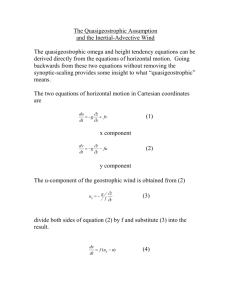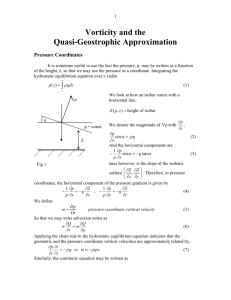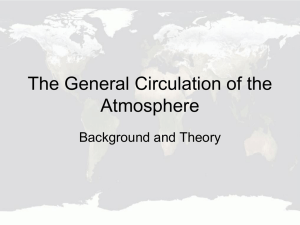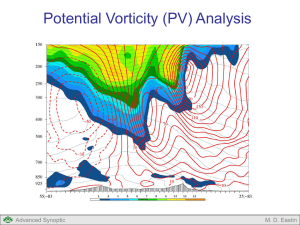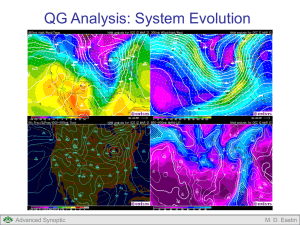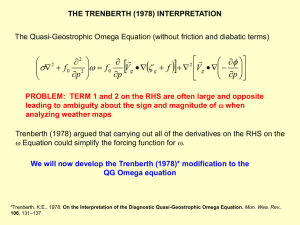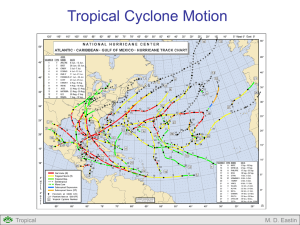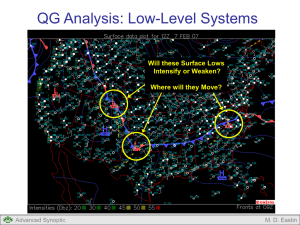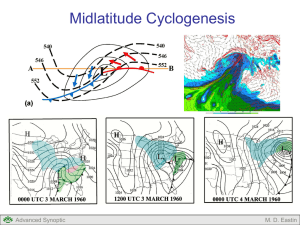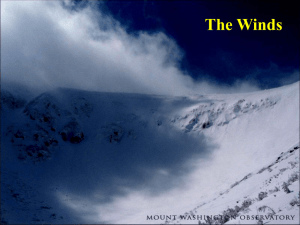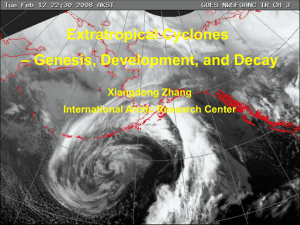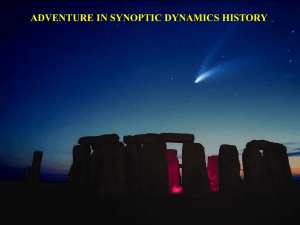QG Theory
advertisement
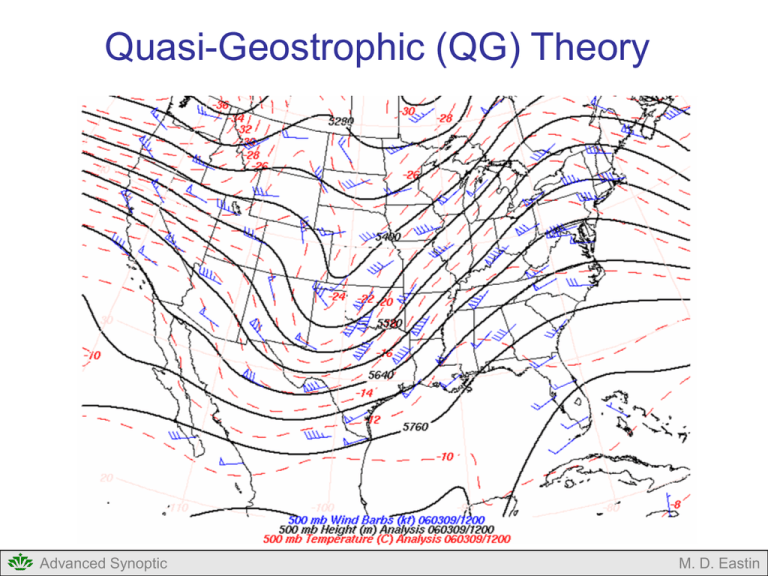
Quasi-Geostrophic (QG) Theory Advanced Synoptic M. D. Eastin Quasi-Geostrophic (QG) Theory QG Theory • Basic Idea • Approximations and Validity • QG Equations / Reference QG Analysis • Basic Idea • Estimating Vertical Motion • QG Omega Equation: Basic Form • QG Omega Equation: Relation to Jet Streaks • QG Omega Equation: Q-vector Form • Estimating System Evolution • QG Height Tendency Equation • Diabatic and Orographic Processes • Evolution of Low-level Cyclones • Evolution of Upper-level Troughs Advanced Synoptic M. D. Eastin QG Theory: Basic Idea Forecast Needs: • The public desires information regarding temperature, humidity, precipitation, and wind speed and direction up to 7 days in advance across the entire country • Such information is largely a function of the evolving synoptic weather patterns (i.e., surface pressure systems, fronts, and jet streams) Four Forecast Methods: Conceptual Models: Based on numerous observations from past events Generalization of the synoptic patterns Polar-Front theory Kinematic Approach: Analyze current observations of wind, temperature, and moisture fields Assume clouds and precipitation occur when there is upward motion and an adequate supply of moisture QG theory Numerical models: Based on integration of the primitive equations forward in time Require dense observations, and accurate physical parameterizations User must compensate for erroneous initial conditions and model errors Statistical models: Use observations or numerical model output to infer the likelihood of of certain meteorological events Advanced Synoptic M. D. Eastin QG Theory: Basic Idea What will QG Theory do for us? It reveals how hydrostatic balance and geostrophic balance constrain and simplify atmospheric motions, but in a realistic manner It provides a simple framework within which we can understand and diagnose the vertical motion and evolution of three-dimensional synoptic-scale weather systems It helps us to understand how the mass fields (via horizontal temperature advection) and the momentum fields (via horizontal vorticity advection) interact to create vertical circulations that result in realistic synopticscale weather patterns It offers physical insight into the forcing of vertical motion and cloud/precipitation patterns associated with mid-latitude cyclones Advanced Synoptic M. D. Eastin QG Theory: Approximations and Validity What do we already know? • The primitive equations are quite complicated • For mid-latitude synoptic-scale motions the horizontal winds are nearly geostrophic (i.e., they are quasi-geostrophic) above the surface • We can use this fact to further simplify the equations, and still maintain accuracy Advanced Synoptic M. D. Eastin QG Theory: Approximations and Validity Start with: • Primitive equations in isobaric coordinates (to simplify the dynamics) • Hydrostatic Balance (valid for synoptic-scale flow) • Frictionless Flow (neglect boundary-layer and orographic processes) Du x Dt Dv Dt p u x DT y fv Zonal Momentum fu Meridional Momentum RT Hydrostatic Approximation p v y Dt p RT Advanced Synoptic p RT pc p 0 Mass Continuity J cp Thermodynamic Equation of State M. D. Eastin QG Theory: Approximations and Validity Split the total horizontal velocity into geostrophic and ageostrophic components v v g v ag u u g u ag (ug, vg) → geostrophic → portion of the total wind in geostrophic balance (uag, vag) → ageostrophic → portion of the total wind NOT in geostrophic balance • Recall the horizontal equations of motion (isobaric coordinates): Du Dt x where D Dt Advanced Synoptic Dv fv Dt t u x v y y fu p and gz f 2 sin M. D. Eastin QG Theory: Approximations and Validity • Perform a scale analysis of the acceleration and Coriolis terms (construct ratios): Du Dt Dv Dt fv fu • For typical mid-latitude synoptic-scale systems: Du Dt fv (10 ms (10 -4 -1 1 5 ) 10 s s )( 10 ms 1 ~ 0 .1 ) • Our scale analysis implies a small Rossby Number (Ro): Ro U f L where Du Dt fv U T T f L U f L R o ~ 0 .1 Advanced Synoptic M. D. Eastin QG Theory: Approximations and Validity • Thus, we can assume: Du →→ fv 0 x Dt Dv fu 0 y Dt • Since by definition (geostrophic balance) →→ fv fu v 1 f x u 1 f y We can also assume: vg 1 →→ f x 1 ug f y v vg v g v ag →→ u ug u g u ag If the ageostrophic component of the wind is small then, we can assume: Du Dt Du g Dv Dt g Dt Dv g Dt g where: D Dt g t ug x vg y Note: This does NOT mean the ageostrophic components are unimportant Advanced Synoptic M. D. Eastin QG Theory: Approximations and Validity Thus, the primary assumption (or simplification) of QG theory is: Ro is small → (a) ageostrophic flow is assumed to be < 10% of geostrophic flow (b) horizontal advection is accomplished by only the geostrophic flow (c) no vertical advection in the total derivative Du g Dt Dt g Dv Dv g Dt g Du Dt D Dt g t ug x vg y • What do our “new” equations of motion look like? Du g Dt g Dv g Dt g x y fv fu • What do we do with the Coriolis accelerations? Advanced Synoptic M. D. Eastin QG Theory: Approximations and Validity • We can make another assumption about the Coriolis parameter (f) that will ultimately simplify our full system of equations: • Approximate the Coriolis parameter with a Taylor Series expansion: f f0 where: f y y →→ f f0 y f o is the Coriolis parameter at a constant reference latitude f y is the constant meridional gradient in the Coriolis parameter • If we perform a scale analysis on the two terms, we find: f 0 y and we can re-write our geostrophic balance equations as: vg ug Advanced Synoptic 1 f x 1 f y 1 →→ vg →→ ug f 0 x 1 f 0 y M. D. Eastin QG Theory: Equations of Motion • If we now combine (a) our expanded Coriolis parameter with (b) our new geostrophic balance equations, and apply the small Rossby number assumption, we obtain the “final” QG momentum equations: Du g Dt g Dv g Dt g f o v ag y v g These are (2.14) and (2.15) in the Lackmann text f o u ag y u g Physical Interpretation: (1) Accelerations in the geostrophic flow result entirely from ageostrophic flow associated with the Coriolis force (2) The Coriolis “torque” acting at right angles to the ageostrophic wind lead to accelerations in the geostrophic wind components perpendicular to the ageostrophic motions Advanced Synoptic M. D. Eastin QG Equations: Continuity Equation • Start with the primitive form of the mass continuity equation in isobaric coordinates: u x v y p • Substitute in: v v v g ag 0 and then using: vg u u g u ag 1 f 0 x ug 1 f 0 y One can easily show that the geostrophic flow is non-divergent, or u g x v g y 0 Thus, the QG continuity is: u ag x v ag y Physical Interpretation: Advanced Synoptic p 0 This is (2.17) in the Lackmann text The vertical velocity (ω) depends only on the ageostrophic components of the flow M. D. Eastin QG Equations: Thermodynamic Equation • Start with the primitive form of the thermodynamic equation in isobaric coordinates: DT Dt T t u T x v T y T p RT pc p J cp • We can combine the two terms containing vertical motion (ω) and apply the primary assumption of QG theory, such that DT Dt p R g J cp This is (2.18) in the Lackmann text where: RT p p • Finally, (a) neglect diabatic heating (J) [for now…we will return to this later] (b) assume static stability (σ) is only a function of pressure DT Dt g p R Physical Interpretation: Advanced Synoptic (a) geostrophic flow is adiabatic (no latent heating) (b) horizontally-uniform static stability (CAPE is the same) M. D. Eastin QG Equations: Vorticity Equation • Start with the “final” QG momentum equations: Du g Dt g Dv g Dt g • Take f o v ag y v g Zonal Momentum f o u ag y u g Meridional Momentum x of the meridional equation and subtract the y of the zonal equation: • Then, after some algebra, invoking non-divergent geostrophic flow, and substituting the QG continuity equation, we get: D Dt g vg f0 g Physical Interpretation: Advanced Synoptic p where: g v g x u g y 1 2 fo The total rate change of geostrophic relative vorticity is a function of (a) the geostrophic advection of planetary vorticity and (b) vortex stretching M. D. Eastin QG Equations: Vorticity Equation Let’s look at the physical interpretations in greater detail: g t Term 1 ug g x vg Term 2 g y vg Term 3 f0 p Term 4 Term 1: Local time rate of change in geostrophic relative vorticity Term 2: Horizontal advection of geostrophic relative vorticity by the geostrophic flow Positive vorticity advection (PVA) will increase the local vorticity Negative vorticity advection (NVA) will decrease the local vorticity Term 3: Meridional advection of planetary vorticity by the geostrophic flow Beta (β) is always positive Positive (or northward) meridional flow will decrease the local vorticity Negative (or southward) meridional flow will increase the local vorticity Term 4: Addition (subtraction) of vorticity due to stretching (shrinking) of the column An increase in the vertical motion with height will increase the local vorticity A decrease in vertical motion with height will decrease the local vorticity Advanced Synoptic M. D. Eastin QG Equations: Reference Summary of the QG Equations: v v g v ag Decomposition u u g u ag of Total Winds f f0 y u g t v g u ag x t t v g v ag ug g y T x ug p vg u g t v g vg x g x t f 0 y T y f o v ag y v g 1 vg Geostrophic Balance f 0 x f o u ag y u g p R Zonal Momentum Equation Meridional Momentum Equation u g Continuity Equation 0 vg Advanced Synoptic 1 Coriolis Approximation vg x ug t T u g ug ug g y x Adiabatic Thermodynamic Equation vg f0 p Vorticity Equation g v g y 0 RT p p v g x u g y Geostrophic Non-divergence Static Stability Relative Vorticity M. D. Eastin QG Theory: Summary QG Theory – Underlying (Limiting) Assumptions Small Rossby Number (advection by only the geostrophic flow) Hydrostatic Balance Frictionless flow No orographic effects ** No diabatic heating or cooling ** Horizontally uniform static stability ** We will discuss how to compensate for these two limitations as we progress through each topic Advanced Synoptic M. D. Eastin References Bluestein, H. B, 1993: Synoptic-Dynamic Meteorology in Midlatitudes. Volume I: Principles of Kinematics and Dynamics. Oxford University Press, New York, 431 pp. Bluestein, H. B, 1993: Synoptic-Dynamic Meteorology in Midlatitudes. Volume II: Observations and Theory of Weather Systems. Oxford University Press, New York, 594 pp. Charney, J. G., B. Gilchrist, and F. G. Shuman, 1956: The prediction of general quasi-geostrophic motions. J. Meteor., 13, 489-499. Hoskins, B. J., I. Draghici, and H. C. Davis, 1978: A new look at the ω–equation. Quart. J. Roy. Meteor. Soc., 104, 31-38. Hoskins, B. J., and M. A. Pedder, 1980: The diagnosis of middle latitude synoptic development. Quart. J. Roy. Meteor. Soc., 104, 31-38. Lackmann, G., 2011: Mid-latitude Synoptic Meteorology – Dynamics, Analysis and Forecasting, AMS, 343 pp. Trenberth, K. E., 1978: On the interpretation of the diagnostic quasi-geostrophic omega equation. Mon. Wea. Rev., 106, 131-137. Advanced Synoptic M. D. Eastin
